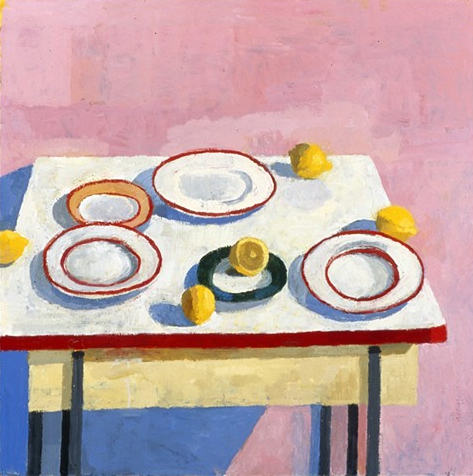Out of a Corner: Loren Boggs, Colleen Kelsey, Marco Hafid Lopez, Don Southard, and Zach Taylor
February 13 – April 3, 2004
Opening Reception: Friday, February 13, 2004, 6-9pm
Linda Warren Gallery is pleased to announce Out of a Corner, an exhibition featuring recent paintings by Loren Boggs, Colleen Kelsey, Marco Hafid Lopez, Don Southard, and Zach Taylor. Out of a Corner features work that explores, expands, and reconstructs traditions from the history of painting, towards the opening of new possibilities within the medium. The bodies of work in this show draw from still life, portraiture, graffiti, advertising, pop and “non-art” painting, and share a common investigation into the shape of painting now.
Loren Boggs’ “giant pink bunny boards” are sardonic and witty investigations into the privileged treatment given to painting. Her paintings on commercially-produced skateboards may be displayed in a gallery setting, but just as easily can be used for skating, which subsequently destroys the image. Skateboarding provides a literal “vehicle” for her art, as it exists underfoot, is temporary, and is rarely seen. The boards are adorned with cartoon-like hyper-feminine images commenting on sex, reproduction, sanitation, illness, and fashion. Her paintings on masonite squares, which will also be featured in the exhibition, deal with similar issues, differing only in that they are static. Though loaded with provocative references, the imagery is naive, accomplishing a sexy quality through luscious surfaces.
In her new “Puritan Series,” Colleen Kelsey draws on traditions of early American portrait painting to create allegorical profiles that invest her images with a living sensibility. She has created these portraits in order to gratify a specific request from her mother to create religious paintings. They are informed by the artist’s upbringing in an Evangelical Christian environment. The historical images that she refers to date from the period before photography marginalized the portrait painter, and before portrait painting became secularized. Works by John Singleton Copley, James Brewster Jr., and James Sanford Ellsworth are re-imagined through alteration of the subject and the incorporation of epigrammatic texts that are placed on banners. The resulting contemporary tableaux (often self-portraits) are new and mysterious presences open to multiple interpretations. They adapt the visual language of Evangelical Christianity and American portraiture toward the creation of a new self-exploratory faith. These portraits disrupt the determined historical sources to which they refer and embody an active, breathing relationship between the artist and her paintings. The paintings become physical, spiritual and personal extensions of her self.
The rich, layered surfaces of Marco Hafid Lopez’s paintings utilize humor and satire in their confrontation and commemoration of personal and universal human struggles. He incorporates line-art and graffiti techniques into his evocation of everyday foibles and vanities, filling the picture plane with idols and scattered detritus. His work has a visionary quality unaccompanied by any of the naivete that is implied by that term. In some of Lopez’s paintings, there is a story of misplaced effort or vain pursuit of wealth. In others, there is a more vague, almost mythological narrative, expressed in language that is both deadly serious and intensely comical.
Don Southard’s still-life paintings open up a poetic conversation between form, rhythm, and color. His works are situated within a tradition that he describes as “Wayne Thiebaud meets Giorgio Morandi meets Piero della Francesca,” often lemons, vessels, fish heads, or place settings, are intentionally neutral, so that visual emphasis is maintained on the painting itself, rather than on a narrative. Beginning with this self-imposed limitation, Southard painstakingly works and reworks the surfaces until the proper relationship between the forms and colors is established. Planes, surfaces, and modest household artifacts co-exist in an environment that denies their objecthood while perpetually re-negotiating their interrelationships.
Zach Taylor’s new works are a mélange of American historical and mythological allusions, featuring robots, vampires, cavemen, pirates, and machines cavorting within a fantastic landscape of the past and future. They address American dreams and American fears, and utilize a variety of traditional and non-traditional paints in creating an array of lines and surfaces. The sometimes apocalyptic imagery may be sourced from pin-up art or commercial advertising, but is not referential in an ironic fashion. While influenced by Pop sensibilities, Taylor’s paintings do not place themselves outside of mass culture. They are filled with characters and stories that defy description, a personal response to “shock and awe&” that creates dramatic new narrative and material juxtapositions.
Loren Boggs is currently enrolled at the School of the Art Institute of Chicago. Colleen Kelsey, formerly resident of Chicago, is an Instructor of Record in the Painting Department at Knox College in Galesburg, IL. Her works included in this show are made possible by a CAAP Grant funded by the Chicago Cultural Center. Marco Hafid Lopez is currently enrolled at The Art Students League in New York. Don Southard is an Associate Professor in the Painting and Drawing Department at the School of the Art Institute of Chicago. Zach Taylor is a graduate of the School of the Art Institute of Chicago.
